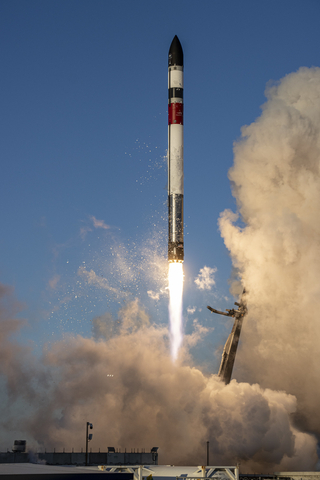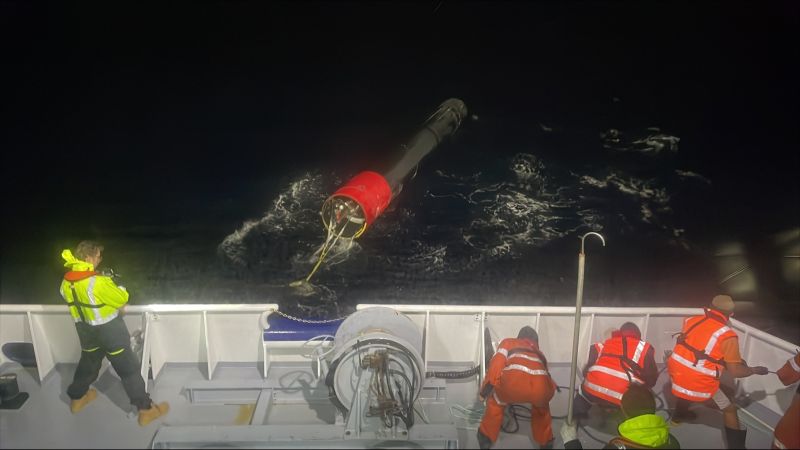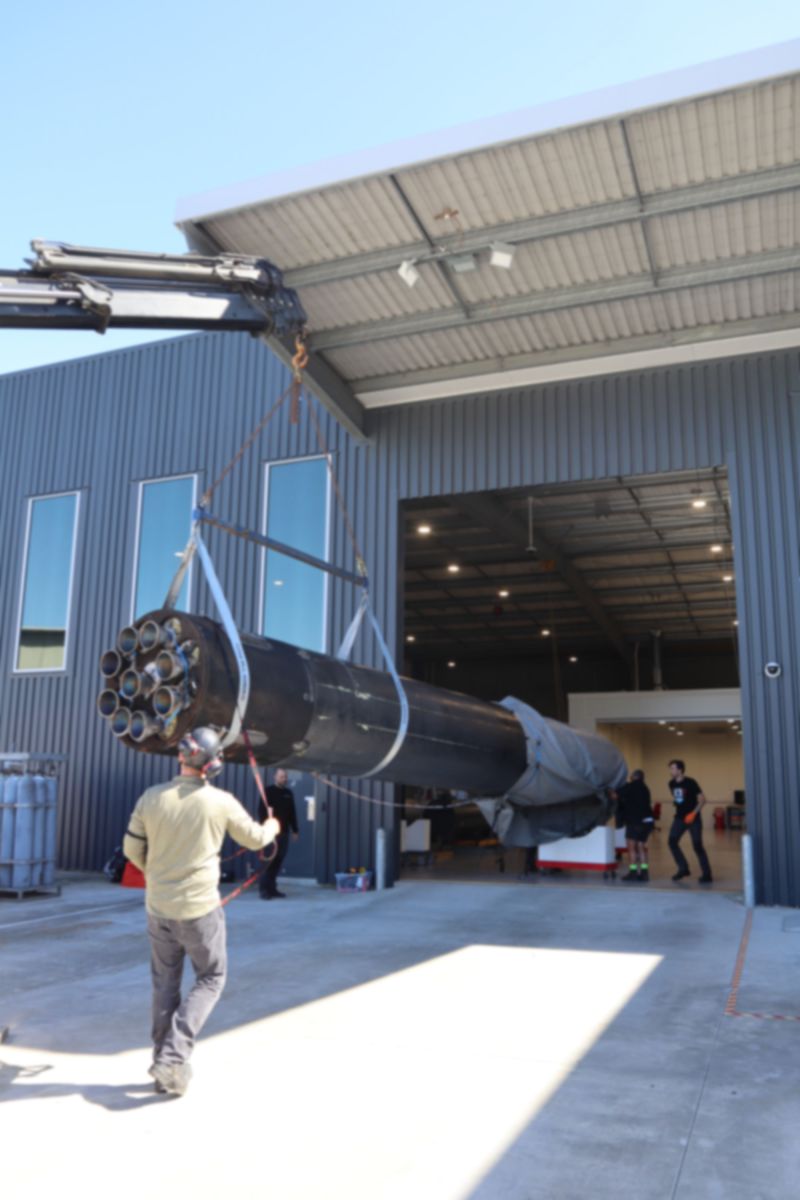For the first time, Rocket Lab (Nasdaq: RKLB) will launch a pre-flown 3D printed Rutherford engine as part of its Electron reusability program. Previously powering the “There and Back Again” mission launched in May 2022, the engine has undergone extensive qualification and acceptance testing to certify it for re-flight, including multiple full mission duration hot fires where the pre-flown engine performed flawlessly and on par with a new Rutherford engine, says the space firm.
With Rocket Lab’s propulsion team now giving the engine the green light for re-flight, it will blast off on an upcoming commercial mission scheduled for lift-off in the third quarter of 2023. While the engine is ready for re-flight now, the Electron rockets scheduled for launch in the second quarter are already built with complete Rutherford powerpack assemblies, so this pre-flown engine will join the production line to be integrated with an in-progress Electron rocket.
The engine is one of several recovered Rutherford engines that have collectively been through many successful full-duration hot fires to support testing and R&D efforts for recovery. The engine joins multiple systems re-flown on Electron, including helium press systems.
 A Rocket Lab Electron launch vehicle lifts off from Launch Complex 1 before the first stage comes back to Earth for an ocean landing and recovery as part of Rocket Lab’s reusability program. Image courtesy of Business Wire.
A Rocket Lab Electron launch vehicle lifts off from Launch Complex 1 before the first stage comes back to Earth for an ocean landing and recovery as part of Rocket Lab’s reusability program. Image courtesy of Business Wire.Designed and built by Rocket Lab, the Rutherford engine is the world’s first 3D printed and electric pump-fed orbital rocket engine. 350 Rutherford engines have been launched into space since Rocket Lab’s first Electron (a two-stage, partially reusable small-class rocket) launched in 2017, making it one of the most reliable and frequently flown U.S. orbital rocket engines.
According to the company, the Rutherford engine’s production scalability is facilitated by additively manufactured primary components, such as combustion chambers, injectors, pumps, and main propellant valves. These can be printed in 24 hours, drastically reducing production timelines compared with traditional production methods.
Peter Beck, the founder and CEO of Rocket Lab, has spoken extensively about the company’s 3D printed Rutherford engines. In several public statements, Beck highlighted the benefits of 3D printing for rocket engine production, including the ability to rapidly iterate designs, reduce manufacturing costs, and improve performance.
One of the advantages of the 3D printed Rutherford engine is its capability to produce a higher thrust-to-weight ratio and greater fuel efficiency than traditional engines, which can help to improve the overall performance of Rocket Lab’s rockets, explained Beck. In addition, the New Zealand entrepreneur has emphasized the role of innovation and new technologies in driving the growth and success of the space industry, and he sees 3D printing as a vital part of that trend.
Rocket Lab works with several 3D printing companies to produce rocket components, including Carpenter Technology for the metal powders used in its 3D printing processes and EOS to 3D print the engine combustion chamber and nozzle for its Rutherford engine. It also relies on SLM Solutions‘ selective laser melting (SLM) machines to 3D print various small components, including valve bodies, brackets, and fittings, and Renishaw’s direct metal laser sintering (DMLS) platforms to 3D print injectors for the Rutherford.
Rocket Lab’s partnerships with these 3D printing companies enable them to access the latest and most advanced 3D printing technologies. Beck has expressed enthusiasm on several occasions about the potential of 3D printing to transform the design and production of rocket engines. During interviews with Forbes and CNBC, he indicated that Rocket Lab would continue to invest in this technology.
 Electron is recovered and Rutherford engines are in great shape after a quick trip to space and a perfect splashdown. Image courtesy of Rocket Lab.
Electron is recovered and Rutherford engines are in great shape after a quick trip to space and a perfect splashdown. Image courtesy of Rocket Lab.Rutherford engines are used for the first and second stages of Electron launch vehicles, with nine engines in the first stage and a single vacuum-optimized engine in the second stage. Re-flying this engine is the latest milestone in Rocket Lab’s program to recover hardware and the first stages from six Electron missions, with the latest stage, retrieved on March 24, 2023, following the “The Beat Goes On” mission launched from Rocket Lab Launch Complex 1 in New Zealand.
Rocket Lab has been iteratively developing and testing two recovery methods in parallel. One is marine recovery, whereby Electron’s first stage returns to Earth under a parachute for a soft ocean splashdown and recovery by boat. Another method is a mid-air recovery, where Electron’s first stage is caught in the air by a specialized helicopter as the stage descends back to Earth under the parachute. Extensive analysis of returned stages shows that Electron withstands an ocean splashdown, and engineers expect future complete stages to pass qualification and acceptance testing for re-flight with minimal refurbishment.
As a result, Rocket Lab is moving forward with marine operations as the primary method to recover Electrons for re-flight. This is expected to take the number of Electron missions suitable for recovery from around 50% to between 60% and 70%. In addition, rocket Lab plans to assess the opportunities for flying a complete pre-flown first-stage booster following the launch of the pre-flown Rutherford engine in the third quarter of this year.
 Electron is recovered and Rutherford engines are in great shape after a quick trip to space and a perfect splashdown. Image courtesy of Rocket Lab.
Electron is recovered and Rutherford engines are in great shape after a quick trip to space and a perfect splashdown. Image courtesy of Rocket Lab.“Electron is already an established workhorse rocket that has been delivering frequent and reliable access to orbit for more than five years. By evolving it into a reusable launch vehicle, we plan to further increase our already steadily rising launch cadence, offering more launch availability to our customers at a time when space access is severely constrained globally,” pointed out Beck.
As stated by the space industry executive, reusability for small rockets is immensely challenging since they don’t have the fuel margins that larger rockets have to enable propulsive landing. However, despite this significant technical hurdle, Rocket Lab has been tenacious about the reusability program and proven it’s possible to bring home small rockets and run the engines as good as new ones.
“This is a major technical achievement and sets a new standard for small launch vehicles globally,” describes Beck. “We’re in this position thanks to our diligent engineers designing robust components and over-qualifying them from the outset of the Electron program to ensure reliability, setting them up well for reuse. We look forward to continuing to rewrite the rules of small launch through reusability while using the extensive data and experience we’re gathering along the way to inform the development of our Neutron rocket which will be an even greater step forward with a fully reusable first stage, interstage and fairing.”
 Electron is recovered and Rutherford engines are in great shape after a quick trip to space and a perfect splashdown. Image courtesy of Rocket Lab.
Electron is recovered and Rutherford engines are in great shape after a quick trip to space and a perfect splashdown. Image courtesy of Rocket Lab.From cost reduction to resource conservation, reusability has become an increasingly important concept in the space industry. Traditionally, space missions involved the launch of a single-use rocket. However, technological advancements have made it possible to design and manufacture spacecraft and rockets that can be reused multiple times.
Furthermore, considering how space debris is becoming an increasingly significant problem in orbit around Earth, by reusing components and resources, Rocket Lab can help reduce the amount of space debris generated by off-Earth missions, decreasing the environmental impact. Learning to reuse assets today will help future space missions with resource conservation, especially considering how limited resources are in space. As interest in the exploration and commercialization of space increases, reusability is likely to play a significant role in the future of the space ecosystem.
Subscribe to Our Email Newsletter
Stay up-to-date on all the latest news from the 3D printing industry and receive information and offers from third party vendors.
Print Services
Upload your 3D Models and get them printed quickly and efficiently.
You May Also Like
Inside AM’s Quiet, Strategic Revolution: An Interview with Dyndrite Founder, Harshil Goel
Founded in 2016 by Harshil Goel, Dyndrite has been clear in its mission from the start: namely, “to fundamentally change how geometry is created, transformed, and transmitted on a computer.”...
3D Printing News Briefs, August 20, 2025: Tool Steel Alloy, Microstructure Control, & More
Today’s 3D Printing News Briefs is all about materials, from recycled metal replacements and a new high-strength alloy to microstructure control in nickel-based superalloys and more. Read on for all...
3D Printing News Briefs, July 23, 2025: ASTM Standard, Defense, Bioinks, & More
We’re starting with business news in today’s 3D Printing News Briefs, as Nikon AM Synergy has appointed a new CEO. Moving on, a proposed ASTM International standard will support 3D...
From Concept to Reality: Nikon AM CEO Hamid Zarringhalam on Executing a Metal 3D Printing Strategy
There are countless metrics you can use, whether quantitative or qualitative, to judge the success of an organization. One of the most important may simply be the organization’s ability to...































